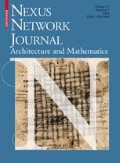Abstract
When contemporary scholars read and interpret historical architectural treatises, one dimension that is frequently lost from the original works is their moral or ethical values. For example, when John Ruskin argues that there are right and wrong geometric shapes in architecture, he may be talking about the difference between mechanical Euclidean curves and freehand quasi-logarithmic ones, but he is, more importantly, also talking about lines that are not simply geometrically but morally correct as well. Similarly, the texts of Vitruvius and Alberti contain rules for the ideal construction of architectural form, but this rightness is first and foremost a moral or ethical quality that is symbolically embodied in a geometric construction. However, while the geometric construction of historic and modern architecture remains the subject of considerable research today, the ethical dimensions in the same architectural techniques tend to be forgotten or are often considered irrelevant to the work. One reason for this shift away from a consideration of the moral dimension in design is, as Levine, Miller and Taylor [2004] observe, that the concept of an ethics of architecture has become increasingly problematic over the last few centuries. This is because throughout the late nineteenth and early twentieth centuries philosophers persuasively argued that only human actions can have ethical connotations. Inanimate and non-sentient objects such as architecture are assumed to be without innate ethical capacity because they do not necessarily shape human responses, actions or behaviours. While in recent years the anthropocentric focus of ethics has been successfully challenged and broadened to include consideration of animals, plants and ecosystems, manufactured or synthetic objects have remained largely excluded from the ethical domain.
Access this chapter
Tax calculation will be finalised at checkout
Purchases are for personal use only
Preview
Unable to display preview. Download preview PDF.
Bibliography
Fox, Warwick. ed. 2000. Ethics and the Built Environment. London: Routledge.
Harries, Karsten. 1997. The Ethical Function of Architecture. Cambridge: MIT Press.
Levine, Michael P., K. Miller, William Taylor. 2004. Ethics and Architecture. The Philosophical Forum XXXV, 2: 103–115.
Spector, Tom. 2001. The Ethical Architect. New York: Princeton Architectural Press.
Wasserman, Barry, Patrick Sullivan, Gregory Palermo. 2000. Ethics and the Practice of Architecture. New York: John Wiley
Author information
Authors and Affiliations
Editor information
Rights and permissions
Copyright information
© 2008 Kim Williams Books, Turin
About this chapter
Cite this chapter
Ostwald, M.J. (2008). Warwick Fox A Theory of General Ethics: Human Relationships, Nature, and the Built Environment . In: Duvernoy, S. (eds) Nexus Network Journal. Nexus Network Journal, vol 10,1. Birkhäuser Basel. https://doi.org/10.1007/978-3-7643-8728-0_12
Download citation
DOI: https://doi.org/10.1007/978-3-7643-8728-0_12
Publisher Name: Birkhäuser Basel
Print ISBN: 978-3-7643-8727-3
Online ISBN: 978-3-7643-8728-0
eBook Packages: Mathematics and StatisticsMathematics and Statistics (R0)

